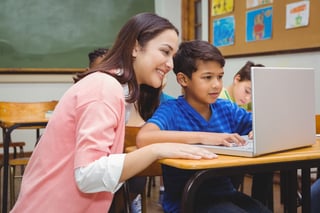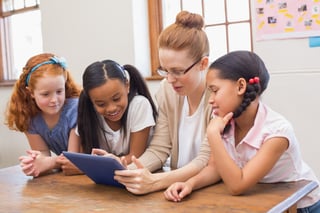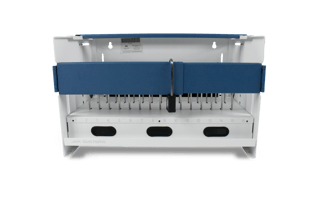
Classroom technology can empower teachers and students by providing tools that encourage learning in ways never before possible. These digital learning experiences offer innovative ways for teachers to engage and educate their students, while preparing them for success in competitive, highly technological world. Jobs today are increasingly relying on technology combined with not only academic knowledge, but analytical, interpersonal, and intrapersonal abilities too.
This means that it is becoming increasingly essential to find ways to use classroom technology to develop the six key competencies of deeper learning: content mastery, critical thinking and problem solving, effective communication, collaboration, self-directed learning, and academic mindset. So, how can classroom technology be used to support deeper learning environments?
1. Content Mastery
Traditional teaching strategies leave little room for content mastery, engagement, and personalization. For this reason, new instructional approaches have been developed, one of which is blended learning. This approach helps fill learning gaps by combining face-to-face learning with classroom technology such as Chromebook, notebook, and tablet devices.
To better cater to students, blended learning offers different pathways for students to acquire, process, relate to, and critically analyze information. The advantages of these are that they help build more individualized and dynamic forms of instruction and assessment for students.
Since many students already use technology outside of the classroom, blending learning also helps students connect what they are learning to real-world situations. This encourages learning to happen anytime, anywhere, and may also help students retain information. When students are successfully able to apply their lessons outside of the classroom walls, this is when they have mastered their knowledge.
Virtual reality is becoming an increasingly popular way to achieve blended learning inside the classroom. If you are interested, check out our previous blog post Getting Started with Classroom Virtual Reality!
2. Critical Thinking and Problem Solving
Integrating laptops and tablets into the classroom gives students access to a nearly unlimited amount of information online. Classroom devices are dramatically changing the ways that students problem solve, as many “answers” can be found on the internet. However, the problem with seeking answers online is that they are not always correct. For this reason, instead of stopping students from seeking answers on the internet, perhaps they should be allowed some degree of freedom with it?
many “answers” can be found on the internet. However, the problem with seeking answers online is that they are not always correct. For this reason, instead of stopping students from seeking answers on the internet, perhaps they should be allowed some degree of freedom with it?
Knowing how to evaluate and use online content is a life lesson just as much as it is an academic lesson. Not all sources are credible and students should be taught how to discern between information that is reliable, fabricated, or maybe just misleading. In this sense, although technology can be a concern to teachers in terms of the information it provides, it can also be a lesson in itself as to the dangers of that information. Perhaps, once students realize that the internet is not always a reliable source, they will even rely on their own critical thinking skills more!
3. Effective Communication
One of the leading ways to communicate in the 21st century is through technology. Using classroom technology to compose writing assignments, make presentations to the class, communicate with teachers and peers, or even practice foreign languages can improve students’ competencies as effective and clear communicators. Practicing these forms of communication will also help to prepare students for their futures, as many of them are regularly used outside of classroom settings.
A convenient and creative way to use technology to communicate in the classroom is by using free web-based student response systems, such as Socrative. This platform provides a way for teachers to engage with and garner feedback from students through on-the-fly questioning, space races, polls, and even formative assessment.
4. Collaboration
Instead of retrofitting classroom technology to an old curriculum, consider re-conceptualizing the curriculum to reflect the new digital resources at your fingertips. With the invention of collaborative web-based softwares, such as G Suite, educational wikis, and learning management softwares like Canvas, teachers and students can now interact and contribute together online.
such as G Suite, educational wikis, and learning management softwares like Canvas, teachers and students can now interact and contribute together online.
These solutions offer teachers new ways to help facilitate collaboration through group projects, inside and outside of the classroom. If you have never considered using wikis in the classroom, take a look at this blog post from eLearning for some inspiration and helpful resources!
5. Self-Directed Learning
We already know that classroom technology can facilitate different types of instruction, and now self-directed learning can be added to that list. Self-directed learning is an instructional process where students are allowed the autonomy to monitor and control their own learning, while still being given feedback and support by their teachers. Its main goals are to encourage students develop a drive to take risks, communicate, make mistakes, and solve problems.
Using applications and web-based software to engage students in personalized learning will help achieve these goals. This is because they will be given more freedom to go at their own pace, explore their own interests, and overcome challenges suited to their skill-level. Further, teachers can use these resources to encourage students to self-assess themselves based on their progression. A list of apps that can help students track, regulate, and assess their progression towards meeting learning objectives can be found published by the Tech Edvocate here.
6. Academic Mindset

Students develop an academic mindset when they feel a sense of belonging and the desire to persist and succeed in their school work. Using classroom technology to make learning fun is one of the best ways engage students and make their work meaningful to them. According to Edutopia, certain games can also provide students with similar interests or goals. This means that, based on the games that teachers choose, students may not only become more engaged in the content, but also develop a greater sense of community with their peers.
Evidently, educational technology can be a valuable resource when it comes to classroom instruction. By using technology to promote the six key competencies of deeper learning in students, you can help promote lifelong learning and the future success your students. However, do not overestimate the power of it. Moving forward, try to keep in mind that educational technology is a means to empower deeper learning, and not an end in itself.
 Get More Cost-Effective Charging and Storage for Your Devices
Get More Cost-Effective Charging and Storage for Your Devices
JAR Systems has developed a wall-mountable charging station that supports Chromebooks, notebooks, and tablet devices. Designed to be different, this versatile solution is simple, durable and affordable. For just $295.00, schools can get the Essential 16 Charging Station and achieve individual security and charging for 16 devices. Click below to learn more about the Essential 16 Charging Station and request more information or a quote!

